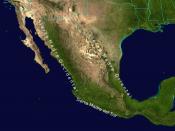Southward from its 1,500 mile long border with the United States lies the Estados Unidos Mexicanos. A country with slightly more than 750,000 square miles in area, Mexico has a vast array of mineral resources, limited agricultural land, and a rapidly growing population. These factors are the basis for many of the country's present problems as well as opportunities for future development. The nation is struggling to modernize its economy. With more than 80 million people in the mid-1980s, Mexico's overall population density exceeds 110 per square mile. More than half of its inhabitants live in the country's central core, while the arid north and the tropical south are sparsely settled.
The stereotype of Mexico is that it is a country with a population consisting mainly of subsistence farmers has little validity. Petroleum and tourism dominate the economy, and industrialization is increasing in many parts of the nation. Internal migration from the countryside has caused urban centers to grow dramatically: more than two thirds of all Mexicans now live in cities.
Mexico City, with a metropolitan area population of approximately 16 million people, is the largest city in the world. While still low by United States standards, the nation's gross national product per capita rose significantly during the 1970s. Despite impressive social and economic gains, since 1981 Mexico has been wracked by severe inflation and an enormous foreign debt brought on in large part by precipitous declines in the value of petroleum products.
Geologically, Mexico is located in one of the Earth's most dynamic areas. It is a part of the 'Ring of Fire,' a region around the Pacific Ocean highlighted by active volcanism and frequent seismic activity. Within the context of plate tectonics, a theory developed to explain the creation of major landform features around the world, Mexico...


